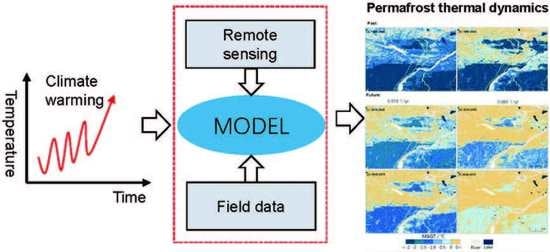High Spatial Resolution Modeling of Climate Change Impacts on Permafrost Thermal Conditions for the Beiluhe Basin, Qinghai-Tibet Plateau
Abstract
:1. Introduction
2. Methods and Data
2.1. Study Area and Field Data Acquisitions
2.2. The GIPL 2.0 Ground Thermal Model
2.2.1. Model Setting and Boundary Condition
2.2.2. Forcing Datasets and Model Initialization
2.2.3. Subsurface Properties and Model Parameters
2.2.4. Model Calibration and Validation
3. Results
3.1. Present Permafrost Distribution
3.2. Historic and Future Permafrost Development in a Warming Climate
4. Discussion
4.1. Model Uncertainties
4.2. Comparison with Other Observations and Results
4.3. Permafrost Change at the Local Scale
5. Conclusions
- The ecosystem types derived from high resolution satellite image provide a reliable and efficient way to scale up the ground thermal parameters and improve the resolution of the model. The GIPL 2.0 model gives a valid picture of the permafrost thermal distribution at 2.0 m spatial resolution. Present permafrost is discontinuous and occupies about 61.4% of the study region, excluding rivers and lakes. MAGT values generally range from −2.0 °C and 0 °C, but vary with ecosystem types. The modeled ALTs are highly related to the MAGT.
- The model results suggest that the permafrost area has decreased rapidly, by 26% since 1986. The mean ALT is modeled to have increased by 0.46 m. According to two climate scenarios, degradation of permafrost is suggested to occur throughout the next 60 years in most regions. A total of 8.5–35% of the area will be involved in widespread permafrost degradation. In the meantime, the average ALT will probably increase by 0.38–0.86 m.
Author Contributions
Funding
Conflicts of Interest
References
- Arctic Climate Impact Assessment (ACIA). Impacts of a Warming Arctic—Arctic Climate Impact Assessment; Cambridge University Press: Cambridge, UK, 2005; p. 1042. [Google Scholar]
- Pepin, N.; Bradley, R.; Diaz, H.; Baraër, M.; Caceres, E.; Forsythe, N.; Fowler, H.; Greenwood, G.; Hashmi, M.; Liu, X. Elevation-dependent warming in mountain regions of the world. Nate Clim. Chang. 2015, 5, 424. [Google Scholar] [CrossRef]
- Qiu, J. The third pole. Nature 2008, 454, 24. [Google Scholar] [CrossRef] [PubMed]
- Vaughan, D.G.; Comiso, J.C.; Allison, I.; Carrasco, J.; Kaser, G.; Kwok, R.; Mote, P.; Murray, T.; Paul, F.; Ren, J. Observations: Cryosphere. In Climate Change: The Physical Science Basis; Stocker, T.F., Qin, D., Plattner, G.K., Tignor, M., Allen, S.K., Boschung, J., Nauels, A., Xia, Y., Bex, V., Midgley, P.M., Eds.; Contribution of Working Group I to the Fifth Assessment Report of the Intergovernmental Panel on Climate Change; Cambridge University Press: Cambridge, UK; New York, NY, USA, 2013; p. 362. [Google Scholar]
- Lawrence, D.M.; Slater, A.G.; Swenson, S.C. Simulation of present-day and future permafrost and seasonally frozen ground conditions in CCSM4. J. Clim. 2012, 25, 2207–2225. [Google Scholar] [CrossRef]
- Kurylyk, B.L.; MacQuarrie, K.T.; McKenzie, J.M. Climate change impacts on groundwater and soil temperatures in cold and temperate regions: Implications, mathematical theory, and emerging simulation tools. Earth-Sci. Rev. 2014, 138, 313–334. [Google Scholar] [CrossRef]
- Li, R.; Zhao, L.; Ding, Y.; Wu, T.; Xiao, Y.; Du, E.; Liu, G.; Qiao, Y. Temporal and spatial variations of the active layer along the Qinghai-Tibet Highway in a permafrost region. Sci. Bull. 2012, 57, 4609–4616. [Google Scholar] [CrossRef] [Green Version]
- Wu, Q.; Zhang, T. Recent permafrost warming on the Qinghai-Tibetan Plateau. J. Geophys. Res. Atmos. 2008, 113, D13108. [Google Scholar] [CrossRef]
- Wu, Q.; Zhang, T. Changes in active layer thickness over the Qinghai-Tibetan Plateau from 1995 to 2007. J. Geophys. Res. Atmos. 2010, 115, D09107. [Google Scholar] [CrossRef]
- Wu, Q.; Zhang, T.; Liu, Y. Thermal state of the active layer and permafrost along the Qinghai-Xizang (Tibet) Railway from 2006 to 2010. Cryosphere 2012, 6, 607. [Google Scholar] [CrossRef]
- Wu, T.; Zhao, L.; Li, R.; Wang, Q.; Xie, C.; Pang, Q. Recent ground surface warming and its effects on permafrost on the central Qinghai–Tibet Plateau. Int. J. Climatol. 2013, 33, 920–930. [Google Scholar] [CrossRef]
- Yang, M.; Nelson, F.E.; Shiklomanov, N.I.; Guo, D.; Wan, G. Permafrost degradation and its environmental effects on the Tibetan Plateau: A review of recent research. Earth-Sci. Rev. 2010, 103, 31–44. [Google Scholar] [CrossRef]
- Ma, W.; Niu, F.; Satoshi, A.; Dewu, J. Slope instability phenomena in permafrost regions of Qinghai-Tibet Plateau. Landslides 2006, 3, 260–264. [Google Scholar] [CrossRef]
- Niu, F.; Yin, G.; Luo, J.; Lin, Z.; Liu, M. Permafrost Distribution along the Qinghai-Tibet Engineering Corridor, China Using High-Resolution Statistical Mapping and Modeling Integrated with Remote Sensing and GIS. Remote Sens. 2018, 10, 215. [Google Scholar] [CrossRef]
- Qin, Y.; Wu, T.; Zhao, L.; Wu, X.; Li, R.; Xie, C.; Pang, Q.; Hu, G.; Qiao, Y.; Zhao, G.; et al. Numerical Modeling of the Active Layer Thickness and Permafrost Thermal State Across Qinghai-Tibetan Plateau. J. Geophys. Res. Atmos. 2017, 122, 604–620. [Google Scholar] [CrossRef]
- Wu, X.; Nan, Z.; Zhao, S.; Zhao, L.; Cheng, G. Spatial modeling of permafrost distribution and properties on the Qinghai-Tibet Plateau. Permafr. Periglac. Process. 2018, 29, 86–99. [Google Scholar] [CrossRef]
- Zou, D.; Zhao, L.; Yu, S.; Chen, J.; Hu, G.; Wu, T.; Wu, J.; Xie, C.; Wu, X.; Pang, Q. A new map of permafrost distribution on the Tibetan Plateau. Cryosphere 2017, 11, 2527. [Google Scholar] [CrossRef]
- Ran, Y.; Li, X.; Cheng, G.; Zhang, T.; Wu, Q.; Jin, H.; Jin, R. Distribution of Permafrost in China: An Overview of Existing Permafrost Maps. Permafr. Periglac. Process. 2012, 23, 322–333. [Google Scholar] [CrossRef]
- Jafarov, E.; Marchenko, S.; Romanovsky, V. Numerical modeling of permafrost dynamics in Alaska using a high spatial resolution dataset. Cryosphere 2012, 6, 613–624. [Google Scholar] [CrossRef] [Green Version]
- Westermann, S.; Schuler, T.V.; Gisnas, K.; Etzelmuller, B. Transient thermal modeling of permafrost conditions in Southern Norway. Cryosphere 2013, 7, 719–739. [Google Scholar] [CrossRef] [Green Version]
- Zhang, Y.; Wang, X.; Fraser, R.; Olthof, I.; Chen, W.; Mclennan, D.; Ponomarenko, S.; Wu, W. Modelling and mapping climate change impacts on permafrost at high spatial resolution for an Arctic region with complex terrain. Cryosphere 2013, 7, 1121–1137. [Google Scholar] [CrossRef] [Green Version]
- Nicolsky, D.J.; Romanovsky, V.; Panda, S.; Marchenko, S.; Muskett, R. Applicability of the ecosystem type approach to model permafrost dynamics across the Alaska North Slope. J. Geophys. Res. Earth Surf. 2017, 122, 50–75. [Google Scholar] [CrossRef]
- Ou, C.; LaRocque, A.; Leblon, B.; Zhang, Y.; Webster, K.; McLaughlin, J. Modelling and mapping permafrost at high spatial resolution using Landsat and Radarsat-2 images in Northern Ontario, Canada: Part 2—Regional mapping. Int. J. Remote Sens. 2016, 37, 2751–2779. [Google Scholar] [CrossRef]
- Ran, Y.; Li, X.; Jin, R.; Guo, J. Remote Sensing of the Mean Annual Surface Temperature and Surface Frost Number for Mapping Permafrost in China. Arct. Antarct. Alp. Res. 2015, 47, 255–265. [Google Scholar] [CrossRef] [Green Version]
- Westermann, S.; Peter, M.; Langer, M.; Schwamborn, G.; Schirrmeister, L.; Etzelmuller, B.; Boike, J. Transient modeling of the ground thermal conditions using satellite data in the Lena River delta, Siberia. Cryosphere 2017, 11, 1441–1463. [Google Scholar] [CrossRef] [Green Version]
- Yin, G.; Niu, F.; Lin, Z.; Luo, J.; Liu, M. Effects of local factors and climate on permafrost conditions and distribution in Beiluhe basin, Qinghai-Tibet Plateau, China. Sci. Total Environ. 2017, 581, 472–485. [Google Scholar] [CrossRef]
- Lin, Z.; Niu, F.; Xu, Z.; Xu, J.; Wang, P. Thermal regime of a thermokarst lake and its influence on permafrost, Beiluhe Basin, Qinghai–Tibet Plateau. Permafr. Periglac. Process. 2010, 21, 315–324. [Google Scholar] [CrossRef]
- Luo, J.; Niu, F.; Lin, Z.; Liu, M.; Yin, G. Thermokarst lake changes between 1969 and 2010 in the beilu river basin, qinghai–tibet plateau, China. Sci. Bull. 2015, 60, 556–564. [Google Scholar] [CrossRef]
- Yun, H.; Wu, Q.; Zhuang, Q.; Chen, A.; Yu, T.; Lyu, Z.; Yang, Y.; Jin, H.; Liu, G.; Qu, Y.; et al. Consumption of atmospheric methane by the Qinghai–Tibet Plateau alpine steppe ecosystem. Cryosphere 2018, 12, 16. [Google Scholar] [CrossRef]
- Wu, Q.; Hou, Y.; Yun, H.; Liu, Y. Changes in active-layer thickness and near-surface permafrost between 2002 and 2012 in alpine ecosystems, Qinghai–Xizang (Tibet) Plateau, China. Glob. Planet. Chang. 2015, 124, 149–155. [Google Scholar] [CrossRef]
- Tipenko, G.; Marchenko, S.; Romanovsky, V.; Groshev, V.; Sazonova, T. Spatially Distributed Model of Permafrost Dynamics in Alaska. In Proceedings of the AGU Fall Meeting, San Francisco, CA, USA, 13–17 December 2004. [Google Scholar]
- Wu, Q.; Zhang, T.; Liu, Y. Permafrost temperatures and thickness on the Qinghai-Tibet Plateau. Glob. Planet. Chang. 2010, 72, 32–38. [Google Scholar] [CrossRef]
- Westermann, S.; Elberling, B.; Højlund Pedersen, S.; Stendel, M.; Hansen, B.U.; Liston, G.E. Future permafrost conditions along environmental gradients in Zackenberg, Greenland. Cryosphere 2015, 9, 719–735. [Google Scholar] [CrossRef] [Green Version]
- Hipp, T.; Etzelmüller, B.; Farbrot, H.; Schuler, T.; Westermann, S. Modelling borehole temperatures in Southern Norway–insights into permafrost dynamics during the 20th and 21st century. Cryosphere 2012, 6, 553–571. [Google Scholar] [CrossRef]
- Rogelj, J.; den Elzen, M.; Höhne, N.; Fransen, T.; Fekete, H.; Winkler, H.; Schaeffer, R.; Sha, F.; Riahi, K.; Meinshausen, M. Paris Agreement climate proposals need a boost to keep warming well below 2 °C. Nature 2016, 534, 631. [Google Scholar] [CrossRef]
- UNFCCC. Adoption of the Paris Agreement; Report No. FCCC/CP/2015/L.9/Rev.1; United Nations: New York, NY, USA, 2015; Available online: http://unfccc.int/resource/docs/2015/cop21/eng/l09r01.pdf (accessed on 29 January 2016).
- Gisnas, K.; Etzelmuller, B.; Farbrot, H.; Schuler, T.V.; Westermann, S. CryoGRID 1.0: Permafrost Distribution in Norway estimated by a Spatial Numerical Model. Permafr. Periglac. Process. 2013, 24, 2–19. [Google Scholar] [CrossRef] [Green Version]
- Lin, Z.; Burn, C.; Niu, F.; Luo, J.; Liu, M.; Yin, G. The thermal regime, including a reversed thermal offset, of arid permafrost sites with variations in vegetation cover density, Wudaoliang Basin, Qinghai-Tibet Plateau. Permafr. Periglac. Process. 2015, 26, 142–159. [Google Scholar] [CrossRef]
- Gubler, S.; Endrizzi, S.; Gruber, S.; Purves, R.S. Sensitivities and uncertainties of modeled ground temperatures in mountain environments. Geosci. Model Dev. 2013, 6, 1319–1336. [Google Scholar] [CrossRef] [Green Version]
- Langer, M.; Westermann, S.; Heikenfeld, M.; Dorn, W.; Boike, J. Satellite-based modeling of permafrost temperatures in a tundra lowland landscape. Remote Sens. Environ. 2013, 135, 12–24. [Google Scholar] [CrossRef] [Green Version]
- Nicolsky, D.J.; Romanovsky, V.E. Modeling Long-Term Permafrost Degradation. J. Geophys. Res. Earth Surf. 2018, 123, 1756–1771. [Google Scholar] [CrossRef]
- Kurylyk, B.L.; Hayashi, M.; Quinton, W.L.; Mckenzie, J.M.; Voss, C.I. Influence of vertical and lateral heat transfer on permafrost thaw, peatland landscape transition, and groundwater flow. Water Resour. Res. 2016, 52, 1286–1305. [Google Scholar] [CrossRef] [Green Version]
- Christensen, T.R.; Johansson, T.; Åkerman, H.J.; Mastepanov, M.; Malmer, N.; Friborg, T.; Crill, P.; Svensson, B.H. Thawing sub-arctic permafrost: Effects on vegetation and methane emissions. Geophys. Res. Lett. 2004, 31. [Google Scholar] [CrossRef]
- Jorgenson, M.T.; Racine, C.H.; Walters, J.C.; Osterkamp, T.E. Permafrost Degradation and Ecological Changes Associated with a Warming Climate in Central Alaska. Clim. Chang. 2001, 48, 551–579. [Google Scholar] [CrossRef]
- Jorgenson, M.T.; Harden, J.; Kanevskiy, M.; O’Donnell, J.; Wickland, K.; Ewing, S.; Manies, K.; Zhuang, Q.; Shur, Y.; Striegl, R.; et al. Reorganization of vegetation, hydrology and soil carbon after permafrost degradation across heterogeneous boreal landscapes. Environ. Res. Lett. 2013, 8, 035017. [Google Scholar] [CrossRef]
- Wu, Q.; Zhang, Z.; Gao, S.; Ma, W. Thermal impacts of engineering activities and vegetation layer on permafrostin different alpine ecosystems of the Qinghai—Tibet Plateau, China. Cryosphere 2016, 10, 1695–1706. [Google Scholar] [CrossRef]
- Nicolsky, D.J.; Romanovsky, V.E.; Tipenko, G.S. Estimation of thermal properties of saturated soils using in-situ temperature measurements. Cryosphere 2007, 1, 213–269. [Google Scholar] [CrossRef]
- Jin, H.; Chang, X.; Wang, S. Evolution of permafrost on the Qinghai-Xizang (Tibet) Plateau since the end of the late Pleistocene. J. Geophys. Res. Earth Surf. 2007, 112, F02S09. [Google Scholar] [CrossRef]
- Peng, H.; Ma, W.; Mu, Y.H.; Jin, L. Impact of permafrost degradation on embankment deformation of Qinghai-Tibet Highway in permafrost regions. J. Cent. South Univ. 2015, 22, 1079–1086. [Google Scholar] [CrossRef]

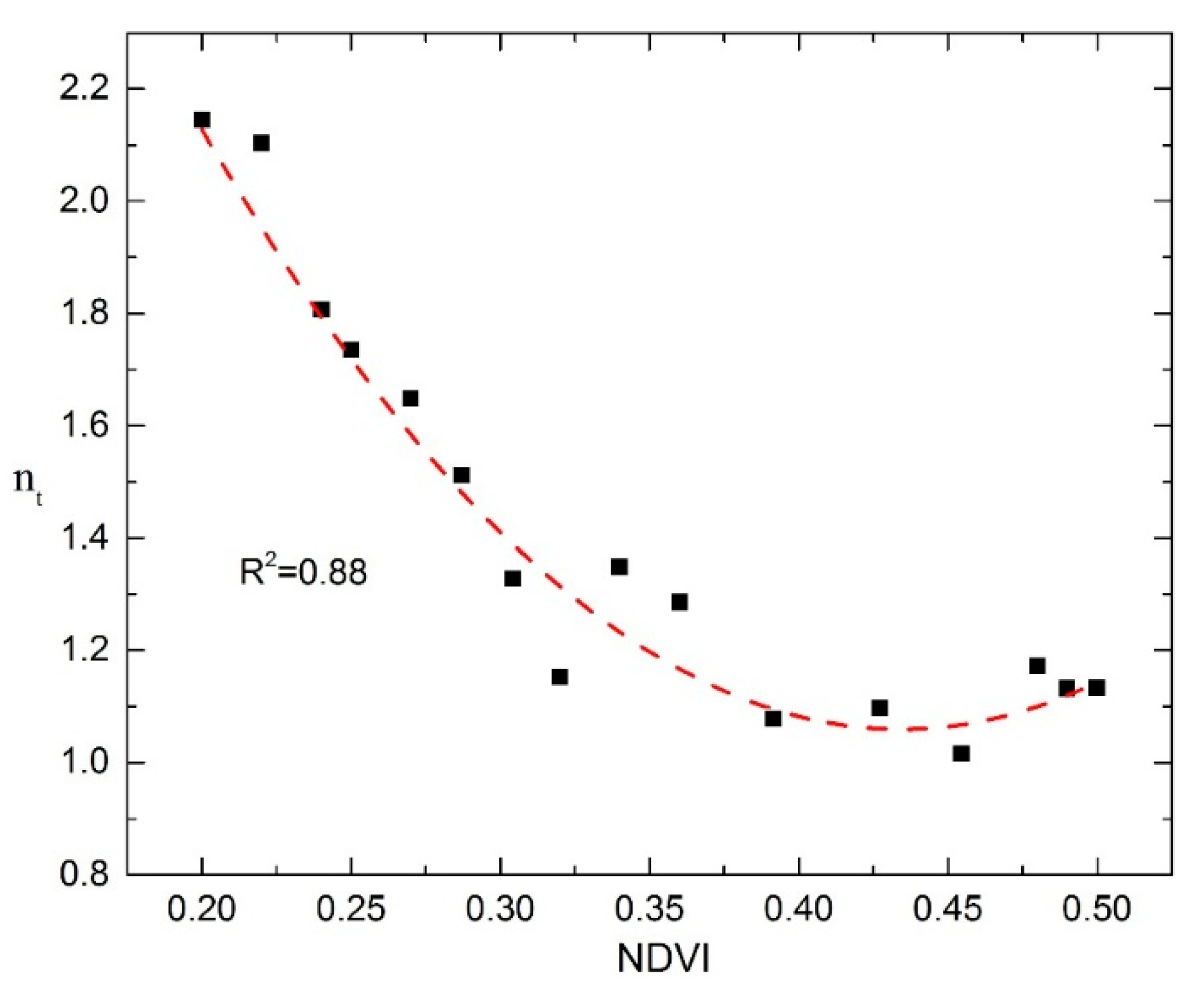

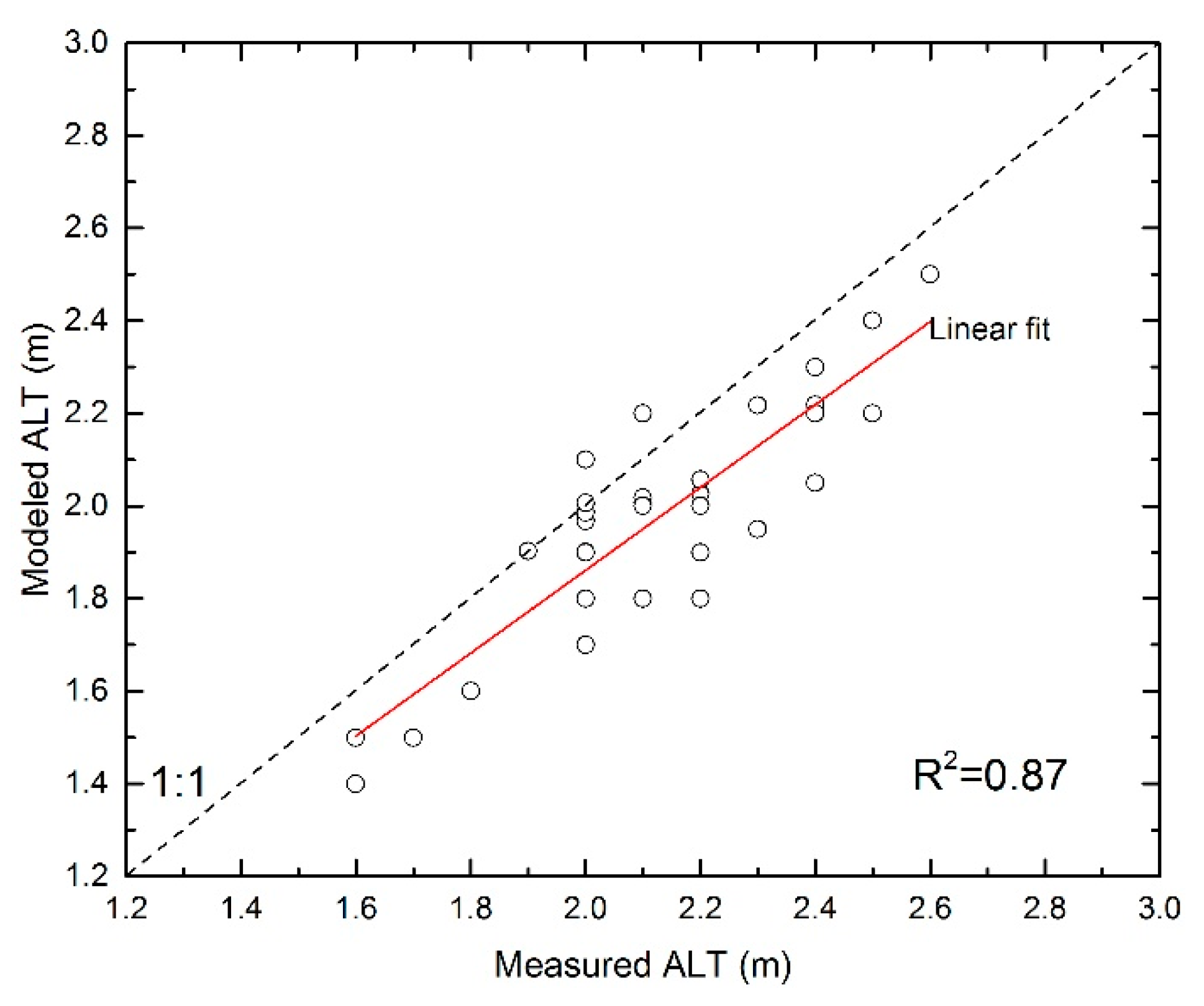
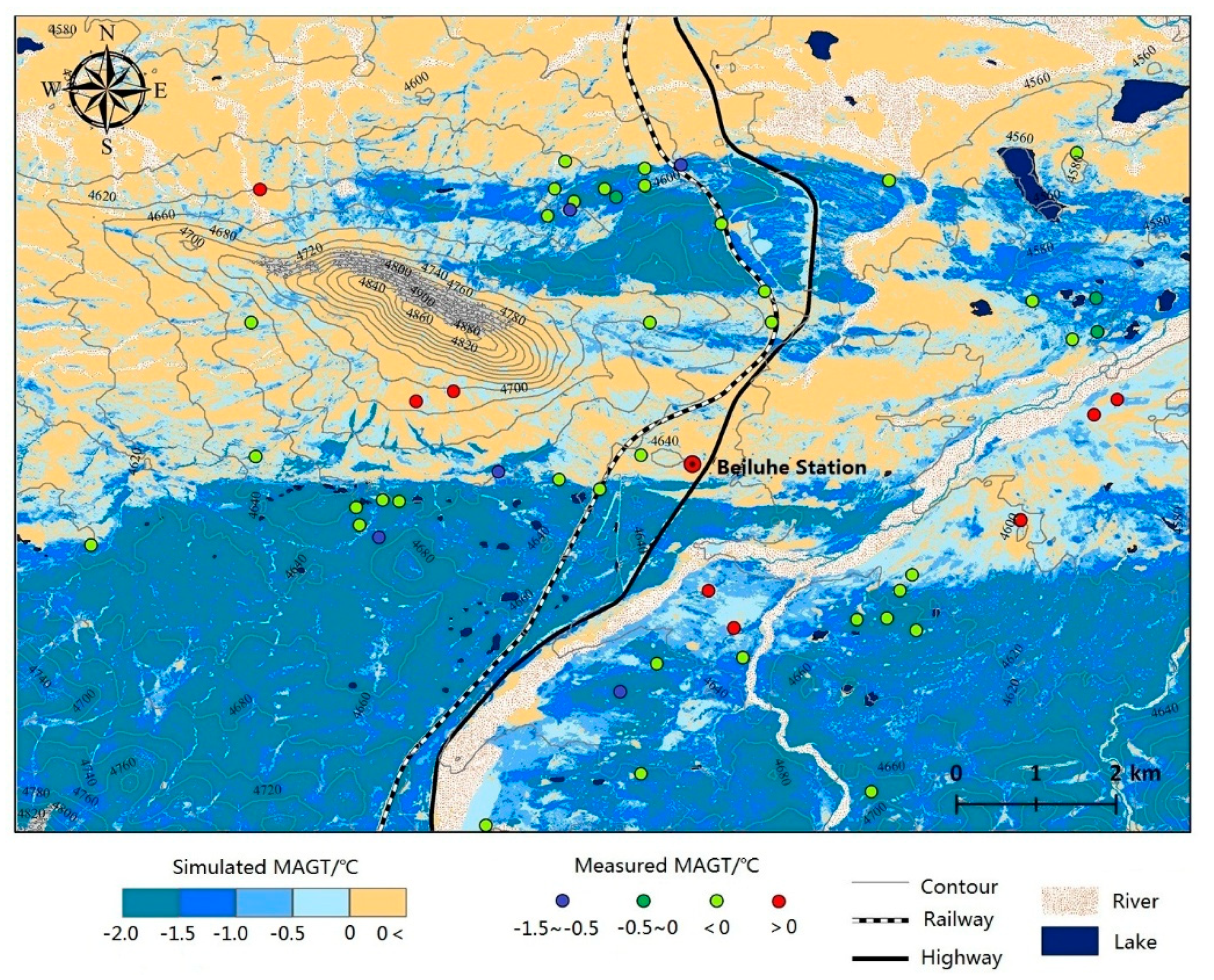

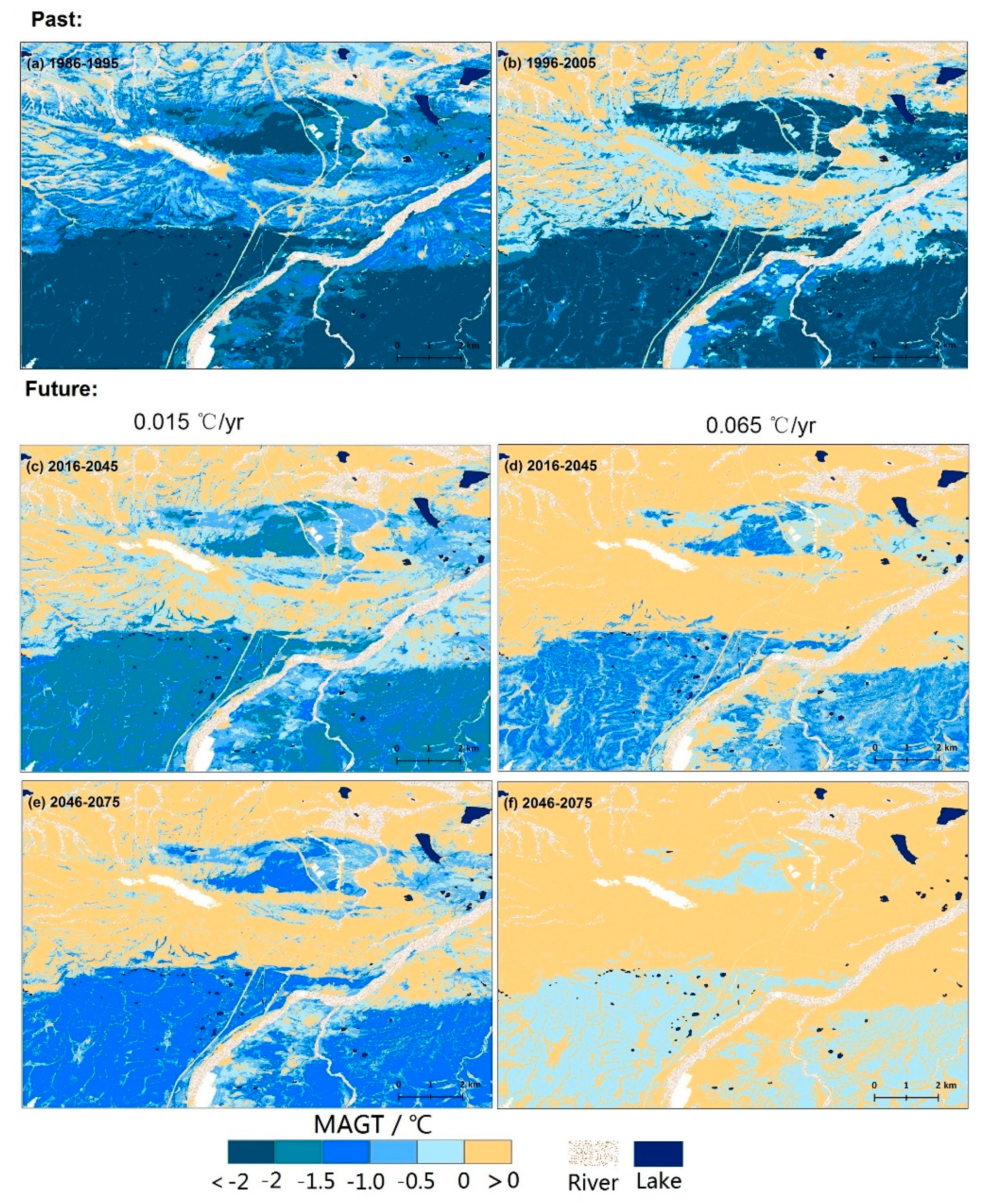
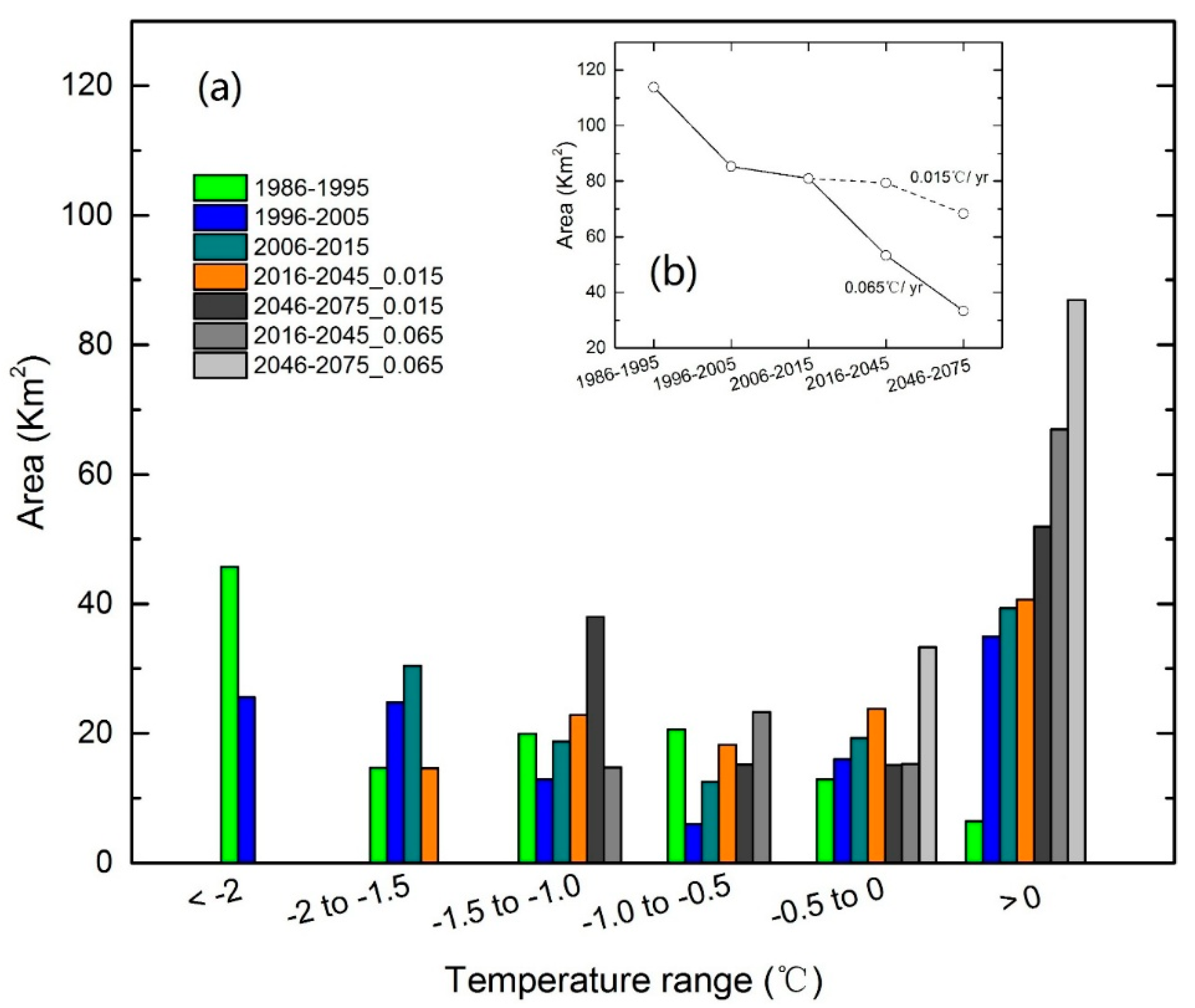
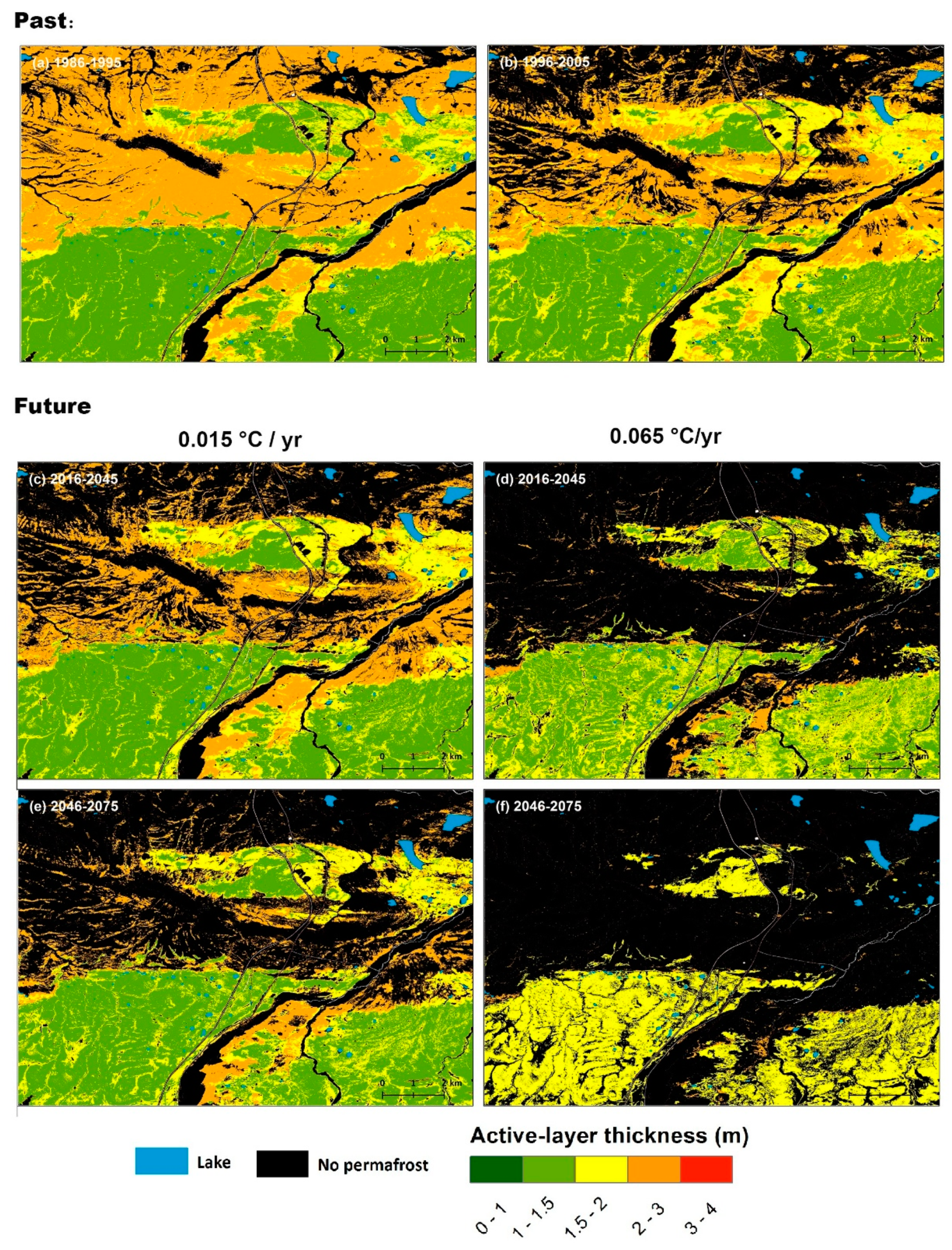

| Class ID | Surface Type | Soil Texture | Class ID | Vegetation | Soil Texture |
|---|---|---|---|---|---|
| 1 | Swamp meadow | Fine sand | 6 | Sparse grassland | Sand with gravel |
| 2 | Undisturbed alpine meadow | Fine sand | 7 | Bare ground | Stone and gravel |
| 3 | Degrading alpine meadow | Fine sand | 8 | Water body | -- |
| 4 | Alpine steppe | Sand with gravel | 9 | Water | -- |
| 5 | Desert alpine grassland | Sand | 10 | Bare ground | Aeolian sand |
| Soil Layer | VWC | UWC | C (106 J m−3) K−1) | K (W m−1 K−1) | Depth (m) | |||
|---|---|---|---|---|---|---|---|---|
| a | b | Ct | Cf | kt | kf | |||
| Swamp Meadow | ||||||||
| Sand | 0.20 | 0.07 | −0.17 | 3.1 | 1.5 | 1.5 | 0.9 | 0–1 |
| Clay | 0.18 | 0.12 | −0.15 | 2.5 | 1.9 | 1.7 | 2.2 | 1–10 |
| Rock | 0.04 | 0.01 | −0.1 | 3.25 | 2.48 | 2.7 | 3.1 | >10 |
| Undisturbed Alpine Meadow | ||||||||
| Sand | 0.18 | 0.07 | −0.17 | 3.1 | 1.5 | 1.6 | 2.4 | 0–2 |
| Clay | 0.17 | 0.12 | −0.15 | 2.5 | 1.9 | 0.7 | 1.4 | 2–10 |
| Bedrock | 0.04 | 0.01 | −0.10 | 3.25 | 2.48 | 2.7 | 3.1 | >10 |
| Degrading Alpine Meadow | ||||||||
| Sand | 0.06 | 0.037 | −0.14 | 2.8 | 2.2 | 1.3 | 1.6 | 0–2 |
| Clay | 0.12 | 0.12 | −0.15 | 2.5 | 1.9 | 1.3 | 1.6 | 2–10 |
| Rock | 0.04 | 0.01 | −0.10 | 3.25 | 2.48 | 2.7 | 3.1 | >10 |
| Alpine Steppe | ||||||||
| Sand with gravel | 0.12 | 0.037 | −0.14 | 2.8 | 2.2 | 1.3 | 1.6 | 0–3 |
| Clay | 0.12 | 0.12 | −0.15 | 2.5 | 1.9 | 0.6 | 1.0 | 3–10 |
| Rock | 0.04 | 0.01 | −0.1 | 3.25 | 2.48 | 2.7 | 3.1 | >10 |
| Desert Grassland | ||||||||
| Sand | 0.1 | 0.05 | −0.17 | 3.1 | 1.5 | 1.3 | 1.6 | 0–5 |
| Clay | 0.12 | 0.12 | −0.15 | 2.5 | 1.9 | 0.6 | 1.0 | 5–10 |
| Rock | 0.04 | 0.01 | −0.1 | 3.25 | 2.48 | 2.7 | 3.1 | >10 |
| Site | Depth (m) | R2 | ME | MAE | RMSE | N |
|---|---|---|---|---|---|---|
| Swamp Meadow | 0.3 | 0.95 | 0.8 | 1.1 | 2.4 | 708 |
| 3.0 | 0.92 | 0.1 | 0.1 | 0.3 | 708 | |
| 5.0 | 0.93 | 0.1 | 0.1 | 0.2 | 708 | |
| 10.0 | 0.94 | 0.0 | 0.1 | 0.2 | 708 | |
| Undisturbed Alpine Meadow | 0.3 | 0.98 | 0.8 | 1.1 | 2.4 | 708 |
| 3.0 | 0.98 | 0.1 | 0.1 | 0.3 | 708 | |
| 5.0 | 0.97 | 0.1 | 0.1 | 0.2 | 708 | |
| 10.0 | 0.93 | 0 | 0.1 | 0.2 | 708 | |
| Degrading Alpine Meadow | 0.3 | 0.98 | −0.5 | 0.8 | 1.8 | 712 |
| 3.0 | 0.95 | 0.0 | 0.2 | 0.2 | 712 | |
| 5.0 | 0.95 | 0.0 | 0.1 | 0.0 | 712 | |
| 10.0 | 0.73 | 0.0 | 0.0 | 0.0 | 712 | |
| Alpine Steppe | 0.3 | 0.88 | 1.1 | 0.6 | 1.2 | 708 |
| 3.0 | 0.90 | 0.8 | 0.8 | 0.5 | 708 | |
| 5.0 | 0.92 | 0.3 | 0.2 | 0.1 | 708 | |
| 10.0 | 0.9 | 0.1 | 0.1 | 0.2 | 708 | |
| Desert Grassland | 0.3 | 0.95 | −0.1 | 0.6 | 0.8 | 697 |
| 3.0 | 0.85 | 0 | 0.1 | 0.1 | 697 | |
| 5.0 | 0.92 | 0 | 0.1 | 0.1 | 697 | |
| 10.0 | 0.92 | 0 | 0.1 | 0.1 | 697 |
© 2019 by the authors. Licensee MDPI, Basel, Switzerland. This article is an open access article distributed under the terms and conditions of the Creative Commons Attribution (CC BY) license (http://creativecommons.org/licenses/by/4.0/).
Share and Cite
Luo, J.; Yin, G.; Niu, F.; Lin, Z.; Liu, M. High Spatial Resolution Modeling of Climate Change Impacts on Permafrost Thermal Conditions for the Beiluhe Basin, Qinghai-Tibet Plateau. Remote Sens. 2019, 11, 1294. https://doi.org/10.3390/rs11111294
Luo J, Yin G, Niu F, Lin Z, Liu M. High Spatial Resolution Modeling of Climate Change Impacts on Permafrost Thermal Conditions for the Beiluhe Basin, Qinghai-Tibet Plateau. Remote Sensing. 2019; 11(11):1294. https://doi.org/10.3390/rs11111294
Chicago/Turabian StyleLuo, Jing, Guoan Yin, Fujun Niu, Zhanju Lin, and Minghao Liu. 2019. "High Spatial Resolution Modeling of Climate Change Impacts on Permafrost Thermal Conditions for the Beiluhe Basin, Qinghai-Tibet Plateau" Remote Sensing 11, no. 11: 1294. https://doi.org/10.3390/rs11111294
APA StyleLuo, J., Yin, G., Niu, F., Lin, Z., & Liu, M. (2019). High Spatial Resolution Modeling of Climate Change Impacts on Permafrost Thermal Conditions for the Beiluhe Basin, Qinghai-Tibet Plateau. Remote Sensing, 11(11), 1294. https://doi.org/10.3390/rs11111294




